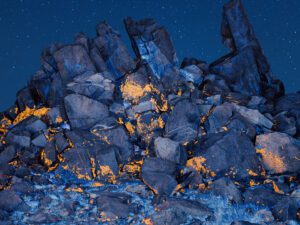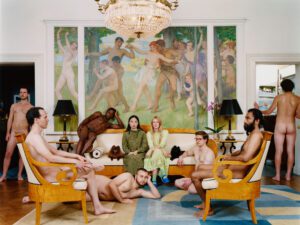The word “photography”, when traced back to its Greek roots, literally means “light writing.” It’s a craft that is utterly dependent on its light source. The sun’s position can change everything – including an image’s atmosphere and clarity. During the mid-1800s, when the medium was in its infancy, it was difficult to craft the conditions for a perfect shot. After all, nature is unwieldy – at any moment, the sun could disappear behind a cloud. In 100 Ideas That Changed Photography (Laurence King Publishing, 2020), Mary Warner Marien describes a would-be cameraperson who “raids the boudoir for mirrors and the kitchen for flat metal trays, and hands the objects to assistants waiting outdoors, ready to aim the polished surfaces in such a way as to shine additional light on an impatient sitter.” Soon enough, artificial light sources became commonplace – from theatre-inspired limelight to experimental battery-powered bulbs and, in the 1880s, the first flash. Now, processing software, like the aptly-named Adobe Lightroom, can do much of the heavy lifting. But the rise of AI generation is causing many creatives to reassess the role of digital technologies in their work; it’s possible this could herald an age of transparency, where photo-editing is disclosed, and analogue processes are embraced once more.

Jessica Backhaus (b. 1970) is a Berlin-based artist who works with a digital camera, yet still manages to strip photography back to its fundamentals. Light, shadow, form and colour are her key tenets. For Cut Outs (2021), she arranged tiny paper shapes under the baking Berlin summer sun. As the pink, blue and yellow pieces started to curl and bend, she pressed the shutter – freezing their dance-like forms forever. Now, her latest monograph, Plein Soleil, charts the next stage in her journey towards total abstraction. These pictures are close-up and zoomed in, showing turquoise pages coiling and casting shadows over contrasting magenta sheets. In 100 Ideas, Warner Marien lists abstraction as Number 67, highlighting Walead Beshty’s Six Colour Curl (2008), a construction made with light-sensitive paper that is then flooded with coloured lights, as a key example. Then there’s American artist Chris McCaw – whose “sunburn photography” shows how intense natural light can be. McCaw discovered its effect when he fell asleep whilst making a long exposure outdoors; the rising sun was so focused and powerful that it burned his film.
A: What’s the step-by-step process of making one of these images? Can you walk us through your approach?
JB: This new series, titled Plein Soleil, came from my longing for colour, as well as my love for paper and light. As the name suggests, I created the images under bright sunlight by placing rectangular and square sheets on top of coloured paper. I then bent and arranged them into paper sculptures. My process is very intuitive and fluid, and Plein Soleil emerged organically, as I positioned and shifted various papers to see where they would take me. Only when I saw the right composition, and felt the proper tension, did I take the final photograph. I am interested in the dialogues that colours can have with each other. Form also plays an important part, and I carefully observe the shadows that appear on the paper. It’s that mixture of light and dark, and the interplay of different tones and shapes, which gives life to these works.

A: What was it like to curate the spreads? There must have been a lot of images to choose from. Is there a particular approach you take to making these decisions? How do you know you’ve found the right shot?
JB: Once I have immersed myself in a project, I can work for days, weeks, months in a row. Then, I’ll take a break and come back to it to make my final choices. I enjoy the selection process very much; it allows me to think more deeply about what I want from the collection. Strangely, I can know instinctively if a photograph is special, and if it will make the final selection, the second I click the shutter. There are various kinds of edits: making choices for an exhibition is different to the process of putting a publication together, for example. In a gallery, the works from Plein Soleil are presented in a large format, as they measure 1.5 x 1.0 metres. These dimensions offer an immersive experience, and I believe that seeing them for real is a completely different experience to on a screen or in a book format. It takes quite some time to work on a sequence that has a good flow. I pay attention to all the shifting elements and aspects: the various shapes, colours, forms and shadows. A lot of it has to do with rhythm, which is why I often listen to music when I edit.
A: The history of what we now call “alternative” photographic processes can be traced to the 19th century, when Anna Atkins published her botanical cyanotypes in the first photobook. What techniques have you tried?
JB: When I started out, I used transparencies and colour negative film for various projects. I had them developed in a lab, made contact sheets and learned how to print them myself. The whole process was analogue, and I spent years in the darkroom. I also used to experiment with different kinds of Polaroid film. Now, I only photograph digitally. That said, I still like to explore by adding various elements to the final photographs: materials like paper, as I’ve mentioned, but also liquid paint, tape or other found material. I am fascinated by the art of collage.

A: Who, or what, are your biggest creative influences?
JB: My main sources of inspiration are painting, music, film and dance. I admire Etel Adnan, a leading 20th century voice for contemporary Arab-American culture, who moved between writing and art seamlessly. There’s also Helen Frankenthaler, a true pioneer of abstract expressionism. She was a key player in the history of post-war American painting alongside the likes of Mark Rothko and his colour fields. When it comes to abstraction, Hilma af Klint, Jean Arp, Raoul de Keyser and Sonia Delaunay are also high up on my list. Plus, International Klein Blue will never cease to move me.
A: Your previous book, Cut Outs, starts with a quote from Delaunay (1885-1979), a pioneer of early abstraction. She talks about her belief that “a genuinely new form of painting will emerge the day we understand that colour has a life of its own.” Do you think this has happened yet? What do colours mean to you?
JB: I believe so. Colours are very important to me – not only within my artwork, but also in everyday life. They are like emotions, and they have their own language. It is interesting to observe how colours interact with each other. I ask: what happens to us when we allow ourselves to be immersed in colour? How do we feel, and how do we react?

A: How does Plein Soleil connect to, or depart from, your other bodies of work? What did you do differently?
JB: Plein Soleil is a logical continuation of Cut Outs, which followed my path into abstraction. Transparent cut paper reacted to the heat of intense sunlight: deforming, rising and casting shadows. These were events in which I had only limited influence. Plein Soleil is a more complex, layered and uncompromising series than those which came before it. I did not cut any of the paper, for example. I simply bent and arranged it in certain ways, and then the sunlight cast the shadows. Before this, I was known more for documentary still lifes. I’m still attracted to that way of working. But I remember – about 15 years ago – I spoke with a curator in Germany. He said: “maybe you don’t see it yet, but I have a feeling that years down the line, you will end up in abstraction.” At the time, I didn’t really believe what he was saying. Unfortunately, he has since passed away but I think of him so often because he was right. He knew me better than I knew myself. And I wish I could show him all these works I’ve made. When you take things away, it’s quite daring. You think the frame is empty, and that there’s nothing there. But, actually, it has everything you need.
A: Are you working on any new projects at the moment?
JB: After Cut Outs, I decided to start The Nature of Things. It will probably remain ongoing for another two years, but it is about the tension and interplay between figuration and abstraction. It zeroes in on everyday objects and situations: cacti, car windows, paperweights. I will admit that, over the last few years, I have become more and more drawn towards abstraction. It offers space to imagine, feel and dream.

A: What do you think the future of abstraction will look like? Are there any contemporary or emerging practitioners whom you are particularly enjoying right now?
JB: It looks bright. It’s a mysterious and fascinating genre, and, for many years, we’ve been witnessing its rise in the contemporary photography space. In terms of ones-to-watch, I very much appreciate the monochrome oil paintings of Suzan Frecon and Irina Ojovan. Erin O’Keefe makes wonderful geometric shapes, and I love Erika Hock’s sculptures. Cécile Bart works between painting and installation, coating translucent screens in paint and arranging them differently. Bart’s images rely on chance, angles and the intensity of sunlight. Hopefully, seeing as the recent influx of AI-generated imagery has led to distrust in pictures that look “too good to be true”, we’ll see a resurgence in the popularity of analogue – or unedited – image processes.
A: Is there anything on your radar for the rest of 2024?
JB: Right now, my exhibition Nous irons jusqu’au soleil is open at the Centre de la Photographie, Mougins, in the south of France. I am showing Cut Outs and The Nature of Things there until 2 June. Plein Soleil will have its premiere at ART Düsseldorf in April with Robert Morat Galerie, and the book will be published then, too. Two other group shows are taking place this spring: Making Light Of Every Thing, at Geneva’s Centre de la Photographie, and then Tagtau. For the latter, I’m exhibiting alongside two German painters at Galerie Anja Knoess in Cologne. Throughout the summer, I’ll be preparing for a solo show in September at MiCamera, Milan. I’ll keep working and experimenting with images, taking them in different directions until I find what is next.
Plein Soleil Kehrer Verlag | Spring 2024
Words: Frances Johnson
Image credits:
1. Jessica Backhaus, Untitled 41, (2023). Courtesy Robert Morat Gallery, Berlin.
2. Jessica Backhaus, Untitled 8, (2023). Courtesy Robert Morat Gallery, Berlin.
3. Jessica Backhaus, Untitled 15, (2023). Courtesy Robert Morat Gallery, Berlin.
4. Jessica Backhaus, Untitled 11, (2023). Detail. Courtesy Robert Morat Gallery, Berlin.
5. Jessica Backhaus, Untitled 5, (2023).Detail. Courtesy Robert Morat Gallery, Berlin.
6. Jessica Backhaus, Untitled 41, (2023). Courtesy Robert Morat Gallery, Berlin.





